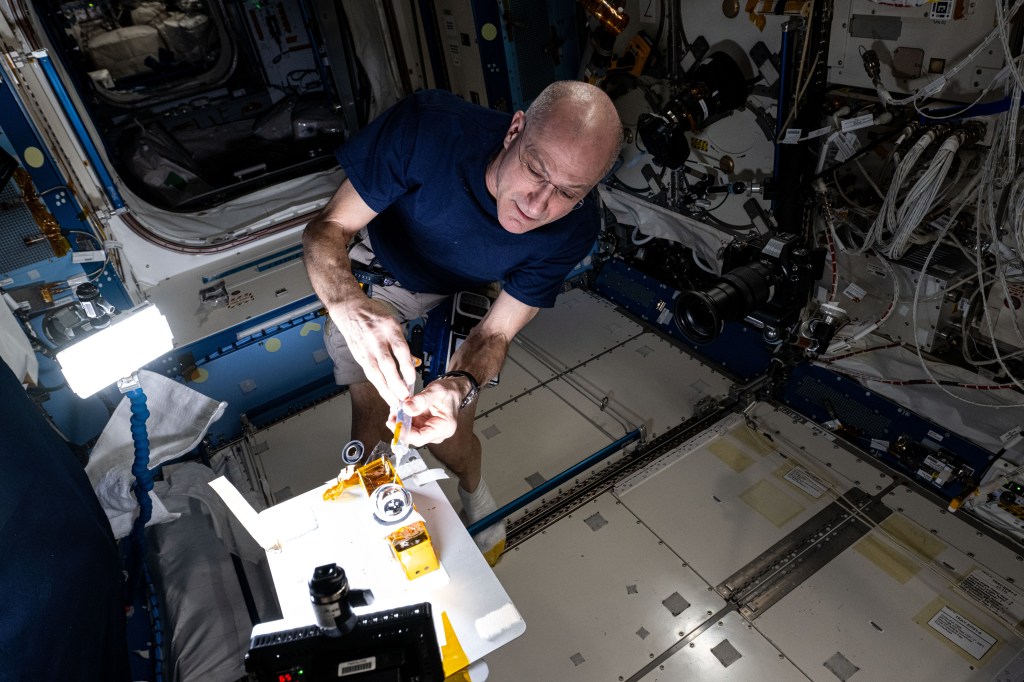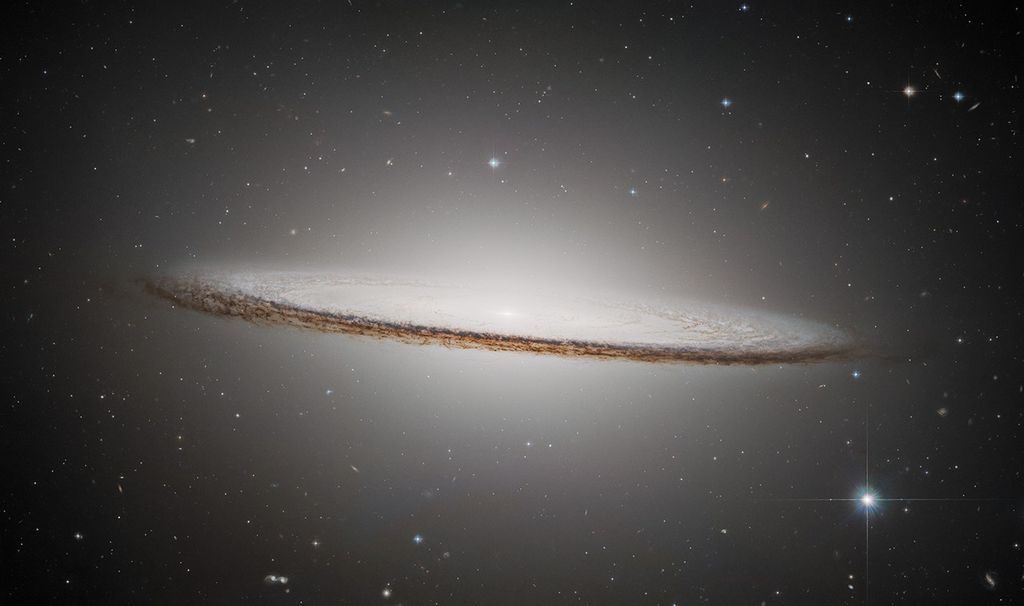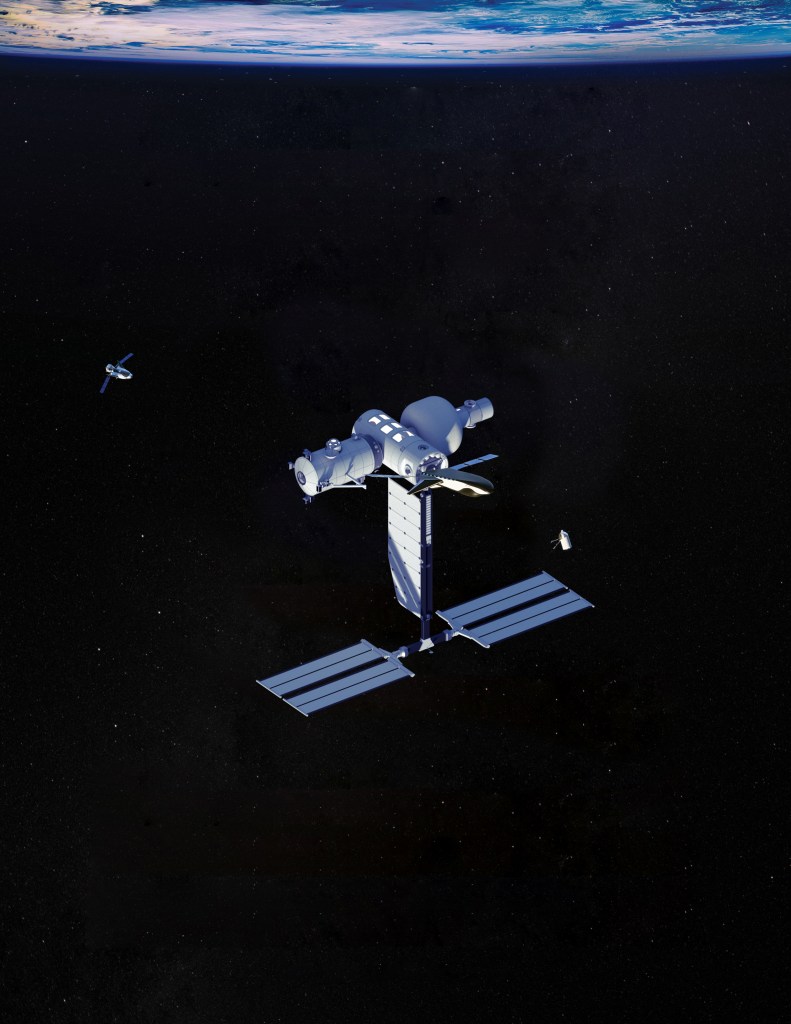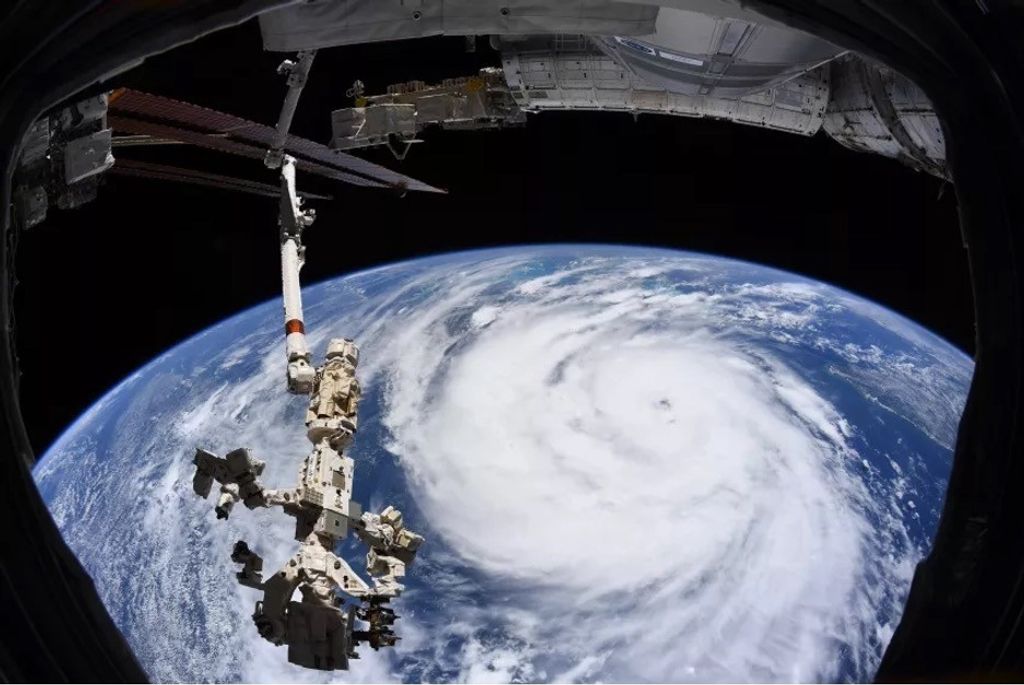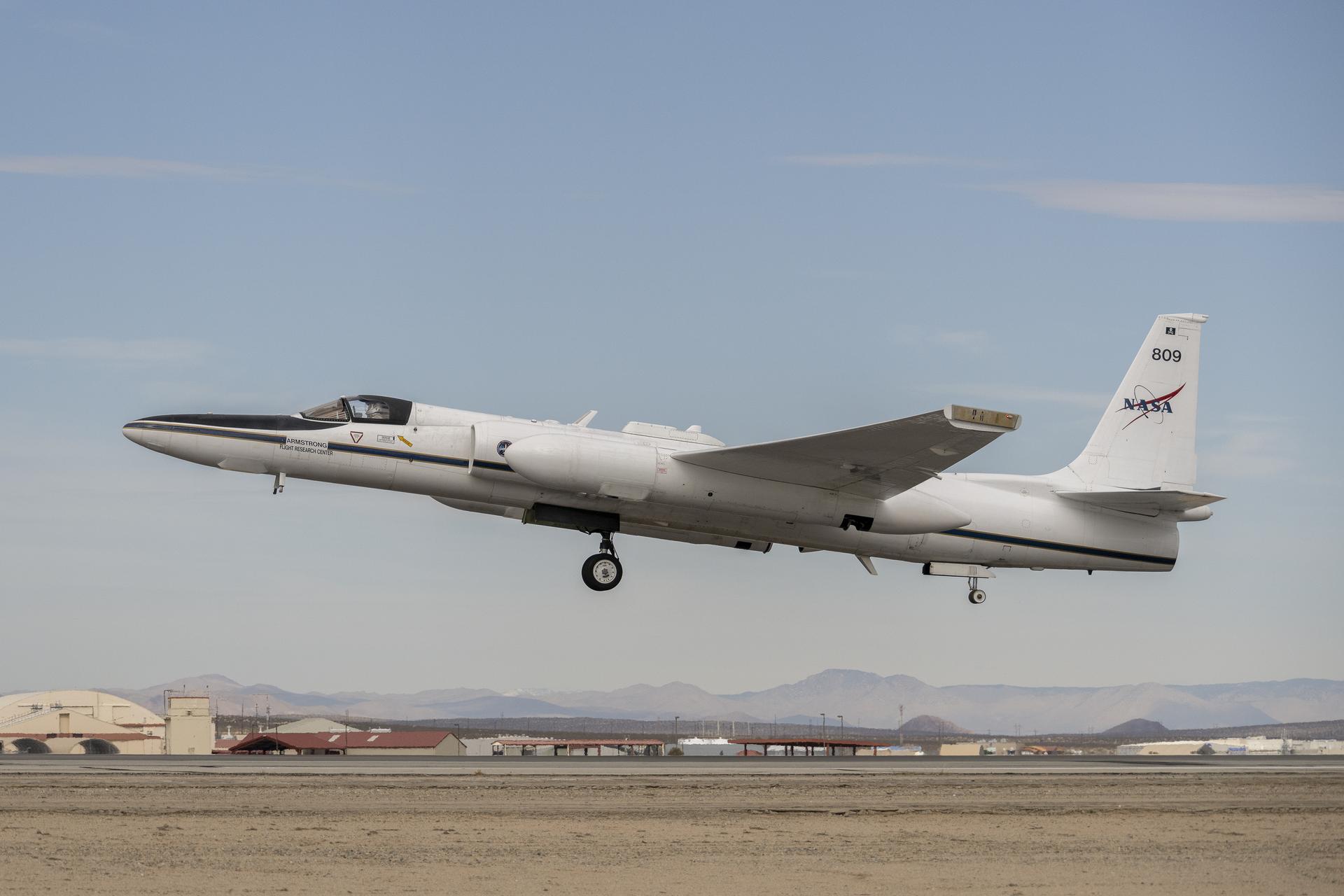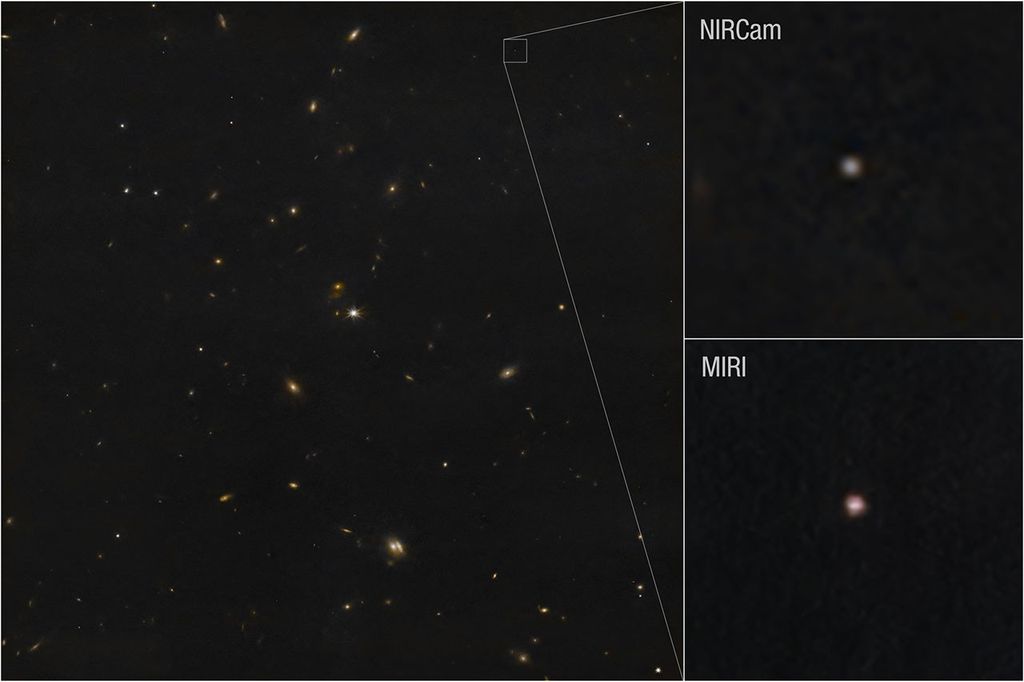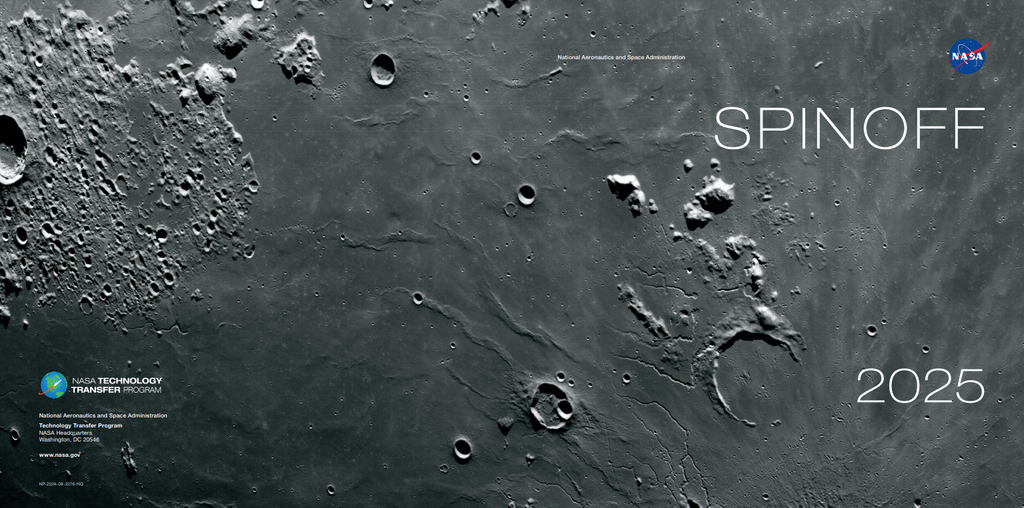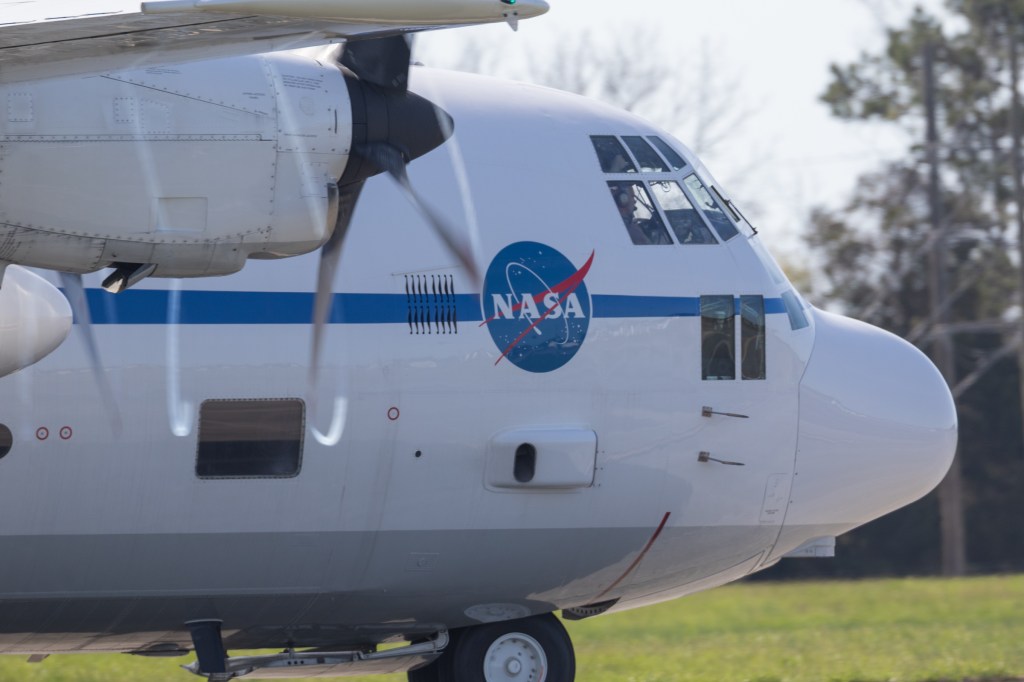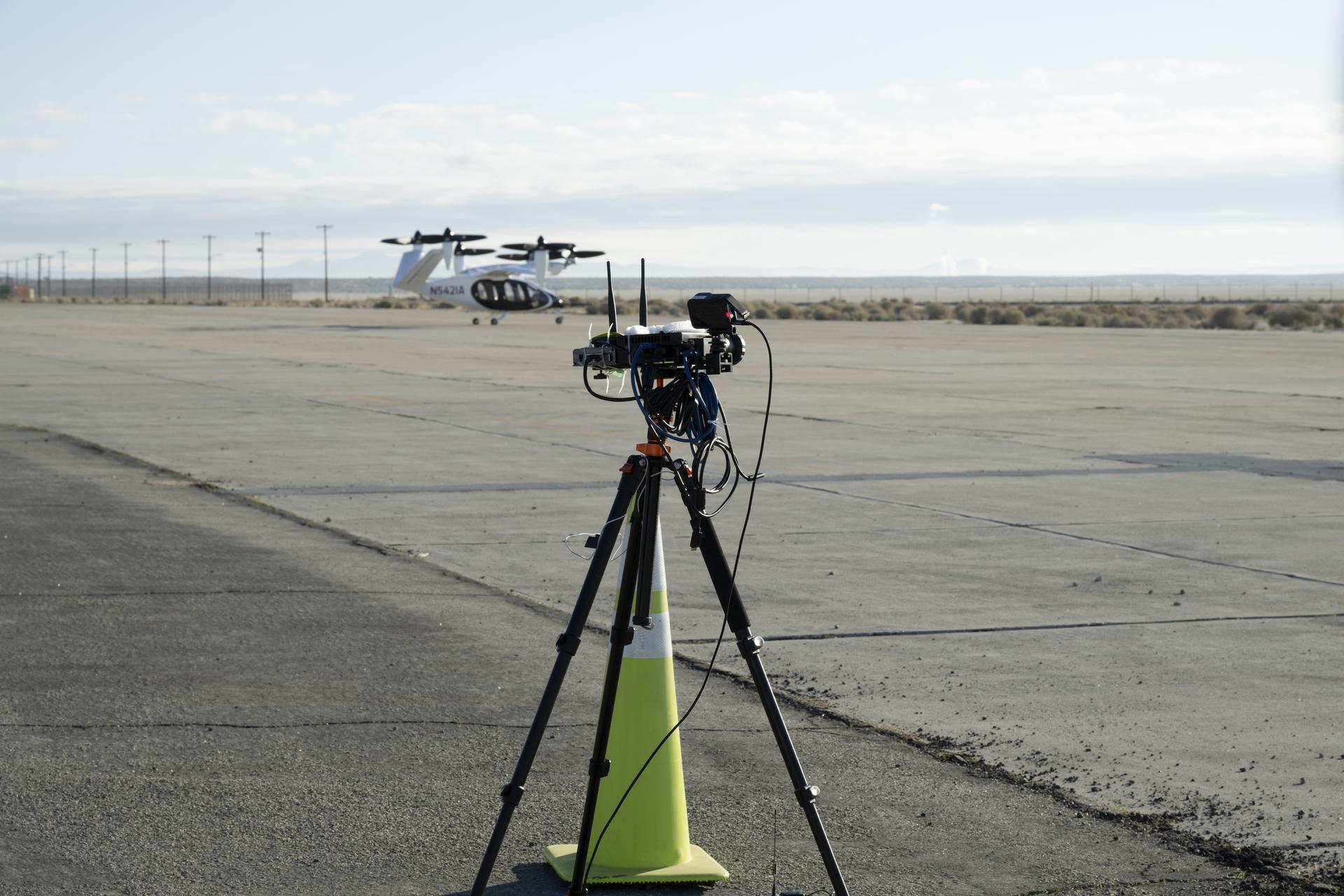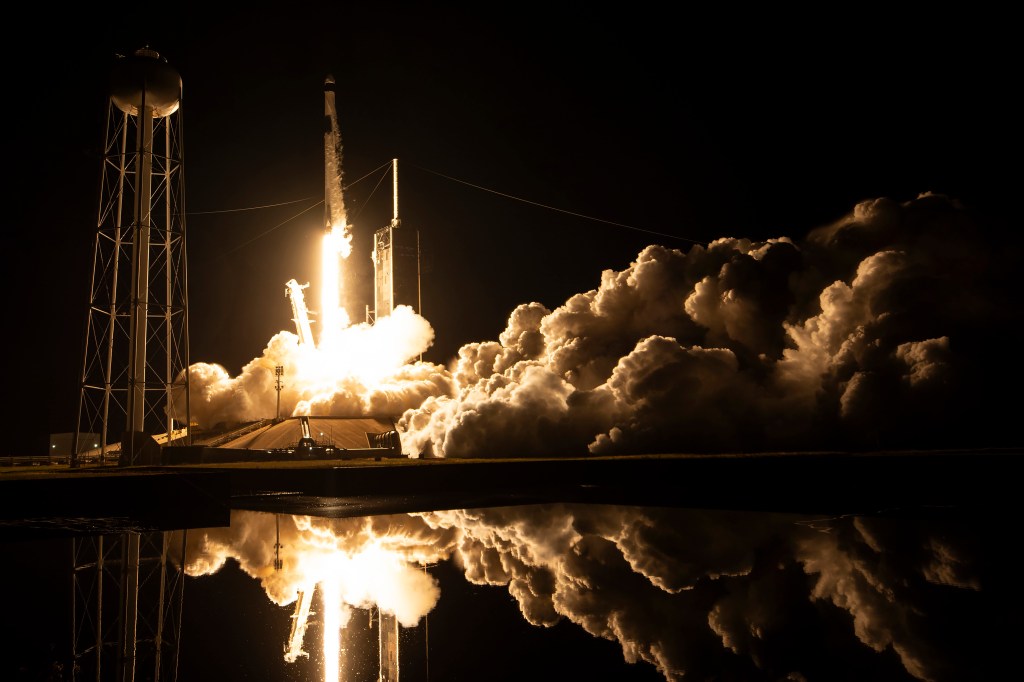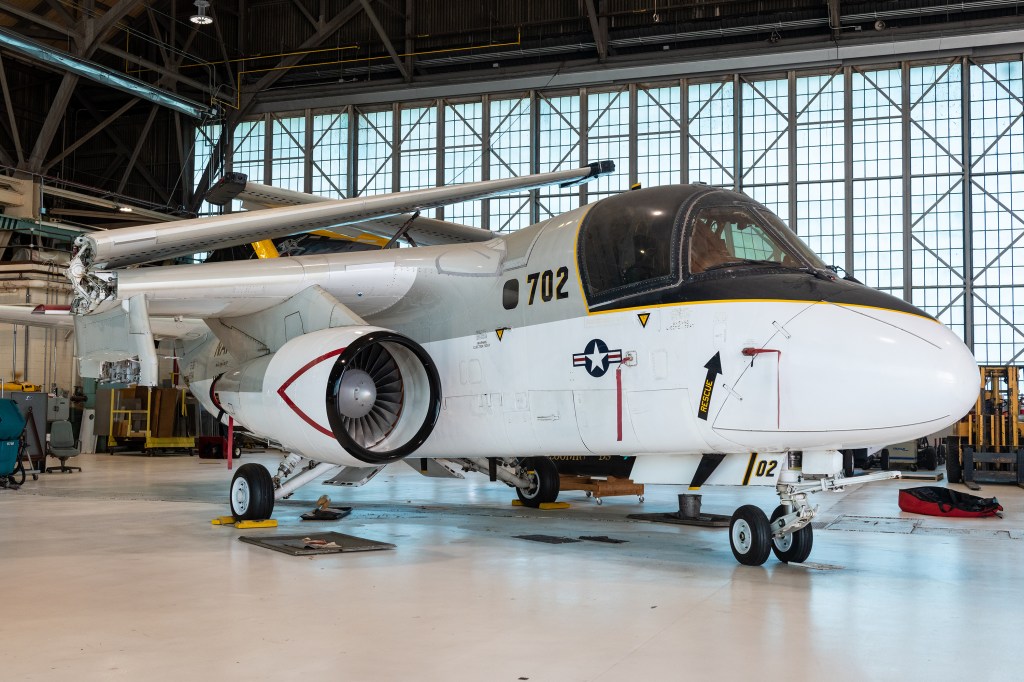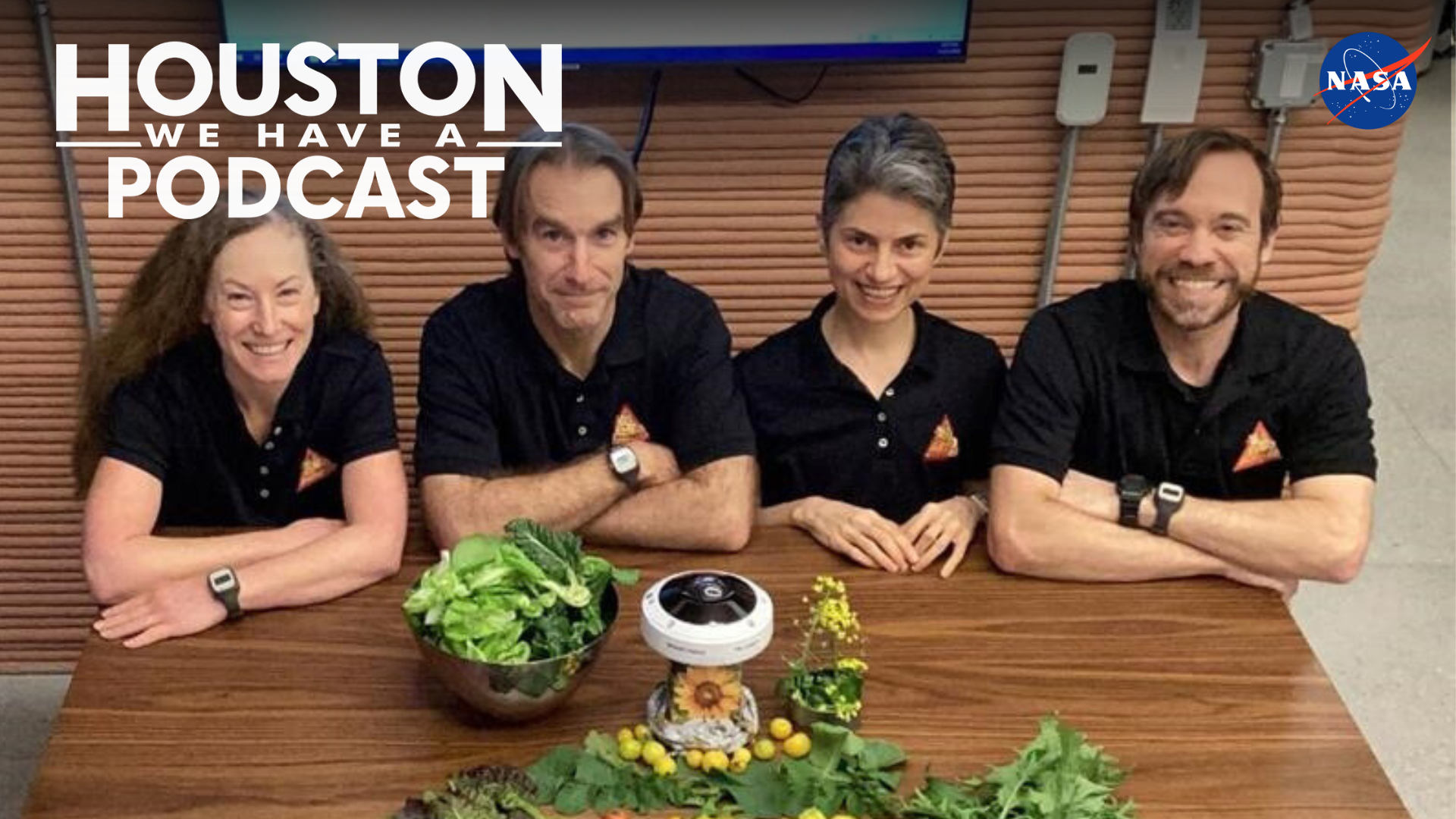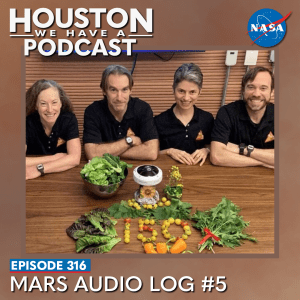
From Earth orbit to the Moon and Mars, explore the world of human spaceflight with NASA each week on the official podcast of the Johnson Space Center in Houston, Texas. Listen to in-depth conversations with the astronauts, scientists and engineers who make it possible.
On episode 316, the CHAPEA crew gives an update in their fifth month of a one-year stay in a simulated Mars habitat and Dr. Suzanne Bell discusses behavioral health and performance of the analog mission. This is the fifth audio log of a monthly series. Recordings were sent from the CHAPEA crew throughout November 2023. The conversation with Dr. Bell was recorded November 15, 2023.
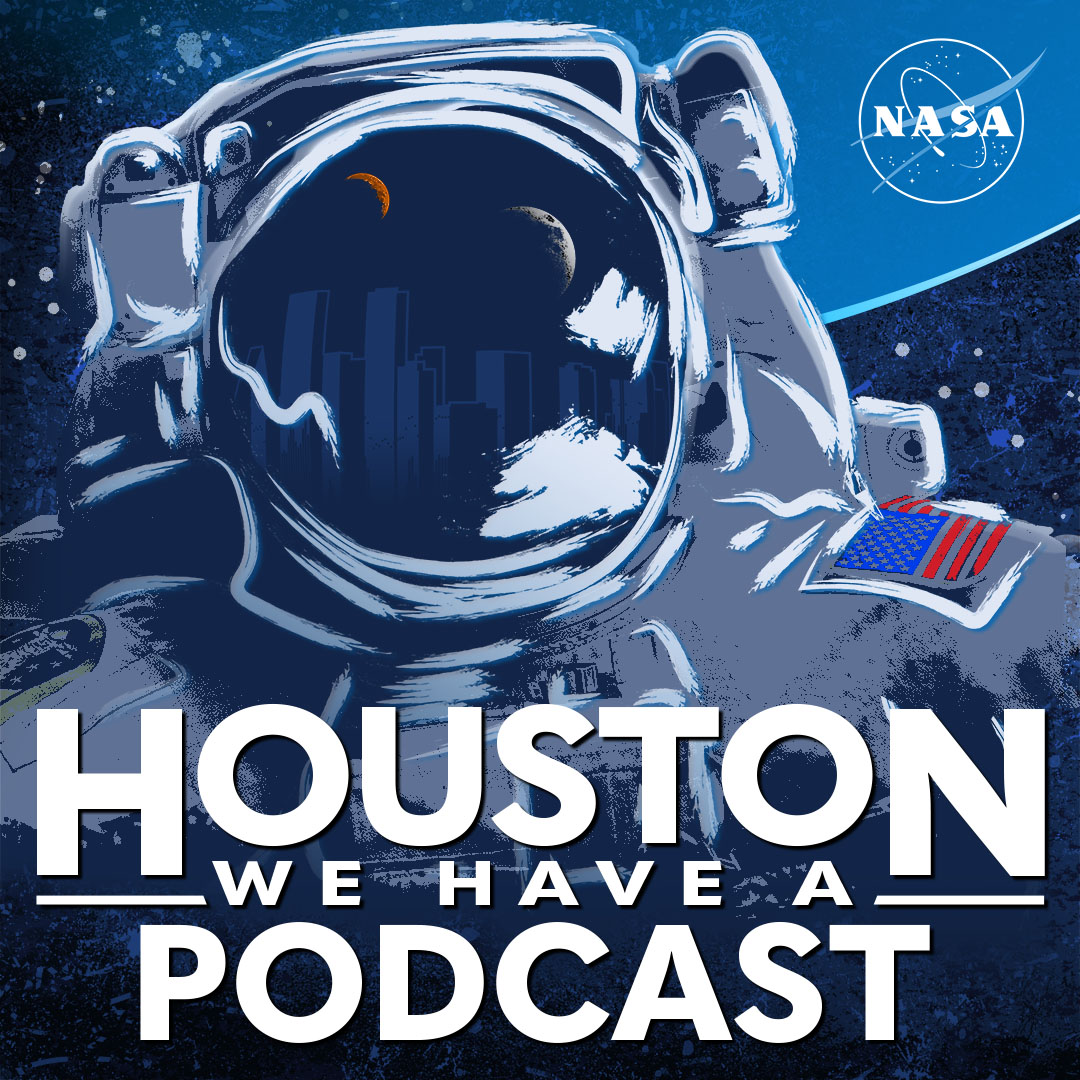
Transcript
Host: (Gary Jordan): Houston, we have a podcast! Welcome to the official podcast of the NASA Johnson Space Center, Episode 316, “Mars Audio Log #5.” I’m Gary Jordan, I’ll be your host today. On this podcast, we bring in the experts, scientists, engineers, astronauts, all to let you know what’s going on in the world of human spaceflight and more. We’re back with another log from the CHAPEA crew. CHAPEA, or Crew Health and Performance Exploration Analog, is a year-long analog mission in a habitat right here on Earth that is simulating very closely what it would be like to live on Mars. We’re lucky enough to have monthly check-ins with the crew: Commander, Kelly Haston, Flight Engineer, Ross Brockwell; Medical Officer, Nathan Jones; and Science Officer, Anca Selariu. To meet the needs of fitting in with this analog and simulating significant communications delays between Earth and Mars that prohibit us from having a live conversation, the crew is recording an audio log based on questions that we draft for them.
On this episode, we’ll play the recording of their fifth month in the habitat, which is right here at the NASA Johnson Space Center, and was recorded in November 2023. We’ll also be bringing on a special guest to learn even more about CHAPEA. This month is on behavioral health and performance. Of course, a year on Mars is a long time, particularly in a confined space, so researchers are looking into understanding how the Mars team performs over that length of time. Our special guest on this episode, Dr. Suzanne Bell, is looking into these team dynamics of a Mars crew and the behavioral health and performance. We’ve had her on the podcast before on an episode titled “The Science of Teams.” So I think we have the right person for this conversation.
Very excited for this month’s audio log because for the first time, all four crew members recorded their audio log together. So with that, let’s learn from the CHAPEA crew on how they’re doing. And Suzanne Bell on the CHAPEA behavioral health and performance. Let’s get right into it.
[Music]
Kelly Haston: Hi, I am Kelly Haston, commander of CHAPEA 1, the one-year Mars analog mission out of Johnson Space Center with NASA.
Ross Brockwell: This is Ross Brockwell. I’m the flight engineer on CHAPEA 1.
Anca Selariu: I am Anca Selariu. I am the science officer of CHAPEA Mission 1.
Nathan Jones: My name’s Nate Jones. I’m the medical officer.
Kelly Haston: Would anyone like to talk about their special tasks from their position?
Nathan Jones: So, as the medical officer, I help the team to organize the collection of biological specimens that are required for the mission. I also would step in if any emergency were to occur, and to help to manage those medically. Also, sometimes make recommendations on how we can help keep crew members safe.
Ross Brockwell: As flight engineer, I’m responsible for making sure that most of the habitat systems are operating nominally.
Anca Selariu: As a science officer, I’m responsible for coordinating science activities, including geology, specimen analysis, biological experiments using seeds, germinating Martian soil stimulant, and other things such as drone and rover activities on the surface of Mars.
Kelly Haston: And as commander, I help organize some of the crew’s communication back and forth with the other people back on Earth that are helping us accomplish this mission. How is everything going to the crew?
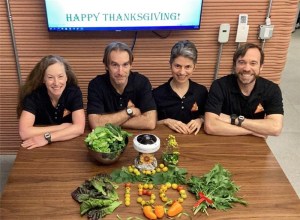
Ross Brockwell: I think it’s still going great. I hope I’m not alone in that opinion.
Anca Selariu: As we’ve insisted on putting on the board early in the mission, probably the first day. Everything is awesome.
Ross Brockwell: Yeah, I’d say we’re doing very well.
Anca Selariu: Still happy, still healthy.
Kelly Haston: I have to agree. I’m actually surprised by how solid and content the crew continues to be as we get deeper to the mission.
Nathan Jones: Yeah, I think there have been things that we plan to do that we probably haven’t gotten to do, and some things that we hadn’t expected that we’ve found interest in. I think I’ve done a lot of guitar playing, and so that’s been fun for me. I haven’t had really much of any of a chance to teach Ross to play.
Ross Brockwell: Still plenty of time though.
Nathan Jones: We’ve got time.
Anca Selariu: Well, between, being Leonardo Da Vinci 2.0 and all the other talents that you had to display, who has time?
Nathan Jones: Yeah, I guess that leads us into another topic. Some of the highlights and activities of the past month. For me, probably one of the best and hardest days, I had a 15-year anniversary with my wife, and obviously, that’s difficult to do whenever you’re away from them, so far away. And so we had to get a bit creative. I had planned on her getting a gift and that didn’t work out. Thankfully, I also had other plans. One was I did a drawing, portrait, I guess you’d say, and I think it turned out pretty well. And then speaking of the guitar, I played and sang a song that I had written, so that was probably my highlight.
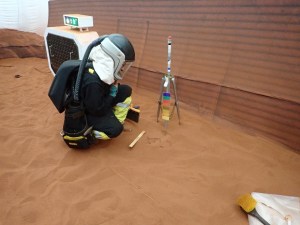
Kelly Haston: I would say it was a highlight for me to watch the drawing that Nate made evolve and move through his process. So as he shared it with us, that was actually really special to see him get ready for that day.
Nathan Jones: Thank you.
Kelly Haston: And we had two special days in October, which we hit a hundred days early in the month, and then we hit a third of the mission completed at the end of the month. And both of those days felt very satisfying, I think and made us really proud.
Anca Selariu: And we also got to experience Kelly’s work, for Thanksgiving, for Canadian Thanksgiving. Your needlework that got on display for a full three days, wasn’t it?
Kelly Haston: It’s true. The crew helped me celebrate Canadian Thanksgiving on October 8.
Nathan Jones: I think it was this last month, I may have accidentally murdered one of our robots, right?
[Laughs]
Anca Selariu: Oh.
[Laughs]
Ross Brockwell: We don’t talk about that.
Nathan Jones: Oh, okay. We had a little technical failure.
Anca Selariu: It was slightly off-nominal, yes.
Nathan Jones: It’ll be fine. We’ve been assured that it will be resolved.
Anca Selariu: Well, we’re going to hope for Operation Phoenix, rise from ashes.
Nathan Jones: It was a funny moment anyway.
Ross Brockwell: We’ve proven we can fix things, so we’ll fix it.
Kelly Haston: That is a really good one though, because I was watching it from the galley where we have a TV that can display some of the activities that are going on in other parts of the hab at times, or even outside when we do EVAs and when the rover sort of when kaput, no problem. I could see it happening. And then I kind of heard Nate call out from the Ivy room, and that was actually really funny.
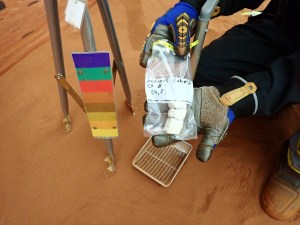
[Laughs]
Nathan Jones: It was the most traumatic death.
[Laughs]
Ross Brockwell: We can rebuild it. We’ve got plenty of duct tape.
Kelly Haston: I would say, if I can commend the crew, that one of the things that has been really awesome is as we continue to do new things have always had to deal with a significant time delay, the crew is very innovative and enjoys the challenge of sort of coming up with troubleshooting solutions. And in the time that we’re waning to hear from MCC if we do need to hear from them, and oftentimes we’ve actually sorted the issue out well in advance of hearing back from them, which can often take up to 40 minutes or longer with the back-and-forth communication. So I think that that’s something that I really think the crew has tightened up on even and was good at from the start, but is really incredible at now.
Nathan Jones: Yeah, I think one of those things that we anticipated but maybe has caught us off guard at moments where we didn’t expect it, you know, were the communication issues and just with the way we communicate, the way things can be lost and misinterpreted or, you know, we assume that mission control understands something we’re trying to explain to them and they don’t, or the other way around. And then you just build off this unstable base and the whole thing is so easily a house of cards that just collapses. You know, thankfully nothing catastrophic has happened, but you can see the benefit of a mission like this.
Anca Selariu: Yeah. It’s really important to go prepared in anticipation of not having much communication. This is for me, a lesson learned for the future crew for Mars. Because very much like us, they’re going to have the same issues with being able to reach back for support. They will basically not be able to. They won’t have the luxury of having immediate support from mission control. They have to be independent. I’m reading here, the question, are there any routine crew bonding experiences that have been consistent over five months? Five months, this is how long we’ve been here for, five months?
Nathan Jones: It’s like three days with you guys.
Ross Brockwell: You must’ve meant weeks, right?
[Laughs]
Kelly Haston: Doesn’t so feel that way. It’s so weird. Really five months?
Nathan Jones: We’ve had some interesting shows we’ve had as a crew time. Some of them worked out, some have been spectacular failures. We are the best movie critics on Mars. I would say, top four for sure.
Kelly Haston: There’s a lot of confidence in that statement.
Nathan Jones: Best basketball team too.
[Laughs]
Kelly Haston: We’ve also decorated the habitat a few times together, or in some cases alone, as a surprise for the others. So I think that that’s really good. That’s been really fun to have days or periods where we have decorations up. For Halloween, I dressed up to surprise our incoming EVA team, and held them at, I guess blaster or glass cordless vacuum point until they coughed up the camera that I needed.
[Laughs]
Anca Selariu: That was pretty awesome. But at least I’m very grateful that I don’t have to ever make a living out of decorating for Halloween.
Nathan Jones: We have a Texas Hold’em game that won’t seem to end.
Ross Brockwell: Someday there’ll be a planetary poker champion where this is all said and done. There’ll be a world champion from Mars.
Kelly Haston: We’re hoping that by the end of the mission, the poker game will be done.
[Laughs]
Anca Selariu: Although every time you go all in.
Nathan Jones: Yeah, I thought I was going to lose and I put all the chips in.
Ross Brockwell: We started a book club, right? I don’t know if we’ve had our first meeting, but the club was official.
Kelly Haston: The club is official. Kind of have continuous meetings about books, I think.
Anca Selariu: Yeah, they’re quite unscheduled.
Kelly Haston: There’s been a lot of reading as well. A lot of reading and other things as well. Anything special coming up in the next month?
Anca Selariu: I am personally looking forward to starting crops of our own in addition to the crops that we have right now.
Nathan Jones: So you like the crops so far? How have the crops been?
Anca Selariu: Yummy.

Ross Brockwell: Yeah, it’s amazing. Having that fresh stuff is fantastic.
Anca Selariu: And having living creatures in the hab is amazing. We keep being drawn.
Kelly Haston: I mean, we are living creatures too.
Ross Brockwell: Yeah, I guess we—
Kelly Haston: Now we have other species as well, is really what we’re trying to say.
Nathan Jones: We have had a single plant die, I think so far, right?
Anca Selariu: Right.
Kelly Haston: So on top of all of the great missions that we’ll have or tasks and activities we’ll have this month, I am actually looking forward to celebrating Thanksgiving, American Thanksgiving, as my family calls it, in the hab with the crew. I think that’s going to be really fun. So that will come up in the next month.
Nathan Jones: Yeah, I’ve managed to convince the crew to share some of my family’s traditions with like Halloween and Thanksgiving’s coming up. And so I’ve got plans to watch all the Charlie Brown specials with them, and hopefully, they enjoy them as much as my family has.
Anca Selariu: And thanks to Nate, I finally saw an episode of Charlie Brown, which actually turned into two episodes, and now I can get references to the great pumpkin.
Ross Brockwell: I’m sure we’ll have a party for halfway, right?
Kelly Haston: Yeah, I think halfway is going to be a really big deal. I mean, as an ultra-runner, I think about it as the 50-mile point and it’s all downhill after that. It’s a slow downhill, but it’ll be downhill. So that’s going to be really cool to celebrate it.
Nathan Jones: I don’t think we’ve developed any formal plans for it yet. We just got past the one-third mark not too long ago, and I don’t think we had anything super big planned for that. But I think probably as for something as big as the halfway mark, we’ll probably have a little celebration of some sort.
Kelly Haston: I think it is also December 31, so we will be celebrating the change in the year as well at the same time, which is kind of cool.
Anca Selariu: Without champagne.
Kelly Haston: That’s true.
Anca Selariu: That’s on the Earth.
Kelly Haston: We’ll be toasting with the tomatoes from the garden.
Anca Selariu: Yes.
Kelly Haston: I can’t imagine that it won’t go without a good celebration.
Ross Brockwell: That’s a question for me. Huh? So CHAPEA’s reignited a passion to contribute to the process of getting us to Mars. Do I have any ideas of how else I might like to contribute afterward? Yeah, I’d really hope that I would get a chance to, I mean, I would think maybe with this experience and some of what I know I could help contribute to the structural and architectural design of spacecraft and habitats. Maybe my work in community infrastructure would be relevant someday for Moon bases and Mars bases and outposts and things like that. So, you know, I would love to have a chance in my career and my life to further contribute. I hope this is a good start.
Anca Selariu: I’m really excited to see the first space colony designed by you.
Nathan Jones: I think we’ve had some discussions at times, you know, about where this road is leading each of us. If this is all that was, you know, meant to be, or if there might be something else down the road formally or informally for each of us. And, you know, it’s part of the excitement of it, anticipation there.
Anca Selariu: I just can’t imagine not being involved in some way and life on Mars at one point or another. I don’t know what form that would take, but it’s been an obsession for so long that I don’t think it can stop.
Nathan Jones: I’m just glad you’re thinking about life on Mars again.
[Laughs]
Kelly Haston: I think that it’s both inspired thoughts of where you can fit into further opportunities in space exploration and safety and so forth. Some somewhat like what this mission is trying to get at, but it also inspires me to think about how we’re living right now and how that might be applicable to changes that we could make on Earth as well that might actually be really important in the coming years, what challenges we’re going to face in humanity here. So I feel like it’s actually really brought that back up for me as well, I feel like the crew talks about those problems a lot. And so it kind of is always percolating in my head as we talk and as we think about our experience here and also what’s outside or what’s back on Earth for us.
Ross Brockwell: Yeah, that’s a really good point. I mean, it definitely makes us think a lot, which we all kind of do anyway about what’s important, you know, not just for survival, but for the human spirit, you know, and for thinking ecologically and on planetary scales. So this context helps us think a lot about that in relation to the Earth as well.
Kelly Haston: Should we finish with a rousing CHAPEA chant?
Ross Brockwell: Or a team battle cry.
Anca Selariu: Battle cry?
Kelly Haston: Ready?
Ross Brockwell: On three.
Anca Selariu: One, two, three…
All: Don’t die!
Nathan Jones: On Mars.
Host: Best battle cry ever. Alright, that was the CHAPEA crew checking in for the month of November. Very great to hear from them. Awesome to hear that they’re in such high spirit still. And I think part of it is a lot of what they described, you know, we were trying to ask about some of these things of what they celebrated, what they did, what they’re looking forward to. And I think a lot of it is these milestones that sort of help to keep them going. Right? Nate, celebrating his 15-year anniversary and having that connection back home, the crew together celebrating milestones like Canadian Thanksgiving and even a hundred days, or a third of the way through their mission. And then Nate even bringing part of his family’s traditions back to celebrate with the crew and getting everybody on board to celebrate together.
These bonding experiences, to hear from them of things that they’ve done and celebrated milestones past and things to look forward to, certainly wonderful to hear these moments from the crew. Now, they mentioned a couple of things that they did through their experience, but thematically, one thing that really stuck out to me was the idea of problem-solving through these different time delays. Where we traditionally have these back-and-forth conversations with crews up in space, and then flight control teams down on the ground with International Space Station operations. In the time that it takes to actually send a problem or send something and wait for communications back, the crew is problem-solving along the way and coming up with solutions while they’re waiting for perhaps some feedback to take them that step closer.
And they talked about developing efficiencies along the way. Very good to hear that. In fact, when we talked with Suzanne Bell coming up here next, part of the thing that she’s excited about, her and many of the research community is excited about, is the fact that built into the CHAPEA mission is this time delay with the ground team. So we’re already seeing the benefits of that in the daily tasks, in the monthly tasks that we’re hearing from the crew. Just hearing about the crew bonding together and doing these activities together and spending time, a lot of time reading. We’re also going to hear from Suzanne Bell about this idea of self-care. And one of those things that’s very important for a crew member that is in this confined space for such a long period of time. A lot of what the crew talked about this month are things that I think translate very nicely to this conversation we have coming up.
So with no further delay, let’s get right to our special guest here. We have Suzanne Bell to talk about the science of behavioral health and performance on CHAPEA. Here we go. Suzanne Bell, welcome back to Houston We Have a Podcast. It’s good to connect in person.
Suzanne Bell: Yeah, nice to see you, Gary.
Host: See, last time we talked was remote. We had to do it during COVID. But we had this wonderful conversation on the science of teams, and we did it with Noshir Contractor and Leslie DeChurch. It was an awesome conversation.
Suzanne Bell: That’s right. They’re long-term collaborators of mine.
Host: Yeah. So what have you been up to since?
Suzanne Bell: Well, we’ve been doing a lot of work related to team dynamics and otherwise. So currently I lead the Behavioral Health and Performance lab at NASA Johnson Space Center. We look at team dynamic issues, but we also look at anything related to behavioral health and individual- and team-level performance.
Host: Yeah. So instead of just really teams, you can even look at the individual side of things, too. So your work is behavioral health and performance from a variety of different angles.
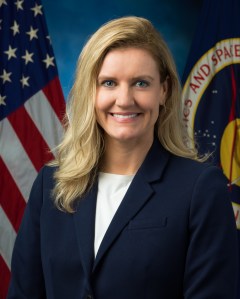
Suzanne Bell: That’s right.
Host: Very good. So, behavioral health and performance. If you had to consolidate that into an idea or a construct, how do you try to characterize what is behavioral health and performance? What exactly are you looking at?
Suzanne Bell: Well, that’s a good question. It means something broadly to most scientists. But for us, we tend to target things related to affect or how you’re feeling, thinking or cognition, as well as behavior. And so in our particular lab, we’re focused on spaceflight issues, but that’s not only the crew up in space. We also think back to how they interact with their family and friends and social support back home, as well as how the crew interacts with mission control. Cause as you pointed out, the beginning with teaming and this idea of teaming is important. It’s not only for the local team or the crew in spaceflight, but they team back with other people on Earth, too.
Host: Oh, interesting. So is it a holistic approach at first? Or are you thinking how is their work affecting other parts of their lives? What’s the approach that you take in terms of behavioral health and performance?
Suzanne Bell: Well, that’s a good question. So right now, there’s Behavioral Health Operations, and they do provide things like family support for the astronauts when they’re in space. Just like any job, there’s always work-life balance. And when you’re up in the ISS, you know, there’s that concern of what’s going on with your family and maybe you feel like you want to be there to support them. But if you feel like your family’s not taken care of, then that can be distracting, you know, where you’re doing very difficult work. So the family unit is supported in current operations, but also as we look to things like Mission to Mars or the Artemis Moon missions, what does that look like and how does that differ as the challenges of space flight include things like significant communication delay? So a lot of what we focus on in the lab is future-focused, thinking about the Artemis missions and the slingshot around the Moon that we have coming up with Artemis II, as well as a long-term presence on the Moon. And then Mars-focused, thinking about that day when we’ll someday land on Mars and what that will look like for behavioral health and performance.
Host: So your role as lead of the lab is not necessarily like the day-to-day operations of a crew. On your day-to-day at your role, are you really consistently thinking ahead and thinking toward some of those future challenges?
Suzanne Bell: Yes, that’s absolutely right. So we partner closely with operations because what we want what we do to be relevant and ultimately implemented and to support the astronauts that will go on future missions. But at the same time in the ISS, behavioral health and performance is fairly well-managed. And so most of what we’re looking at is for the challenges of the Artemis missions and the Mars missions. We do collect some data in the International Space Station right now, both as an environment with some of the conditions we’ll expect for future spaceflight. But we collect a lot of our data in what are called analog missions, such as CHAPEA, where we can mimic some of the realities and challenges we expect for future spaceflight in different environments. And look to see how it affects behavioral health and performance as well as pilot test and develop and validate what is called countermeasures or interventions on how to best support those crews of the future.
Host: There are several different analogs, right? But of course, we’re going to be talking about CHAPEA now and we’ve been talking about this as part of our audio log monthly check-ins with the crew and with special guests. And one of the questions we ask, and I’m curious to hear yours is for you, for the perspective of behavioral health and performance, what happened with the start of CHAPEA? When were you getting involved? When did you hear about this and start being a part of it?
Suzanne Bell: Well, I’m a co-investigator on the project. And I’ve been involved in the project about three years as a co-investigator. The project, you had Dr. Grace Douglas on a previous episode, and I think it was five or six years that the project’s been in the making from the time of the proposal. My predecessor had played a role in that as well as the current team in Behavioral Health. But starting about three years ago, I think my first meeting, that’s when I became the lab lead. About three years ago, I think my first meeting might have been related to the architectural design and choosing what the habitat would actually look like. And then from that, a series of meetings where we really helped to inform and guide the development of the analog itself and being built. CHAPEA is really amazing because it’s not only all the research that’s done, but the engineering team that built it and us together. And really, Grace has done a fabulous job of bringing in multiple perspectives at each step of the way to try to make it as Mars-habitat-realistic as possible. So we can really mimic these, you know, conditions that like to be very challenging.
Host: Fascinating. So you were involved with even the habitat and the space and all of that stuff, but thinking less so from an engineer and the square footage and things, but more so from the human aspect? So what would be the ideal layout for a human living on Mars from behavioral health and performance aspect?
Suzanne Bell: That’s right. And not just my team’s expertise, but other people weighed in on that as well. Habitability experts and others to try to try to make things consistent with what we might expect from Mars.
Host: So in addition to laying the foundation for making this successful, what was going through your head of, “Ooh, this is a good opportunity for continuing to study behavioral health and performance?”
Suzanne Bell: Oh, it’s an incredible opportunity. One thing we’re seeing in our data with shorter analogs versus the handful of longer analogs that we’ve been able to collect data on, is that certain factors do really have additional challenges when you’re talking about long-term isolation. So we’ve collected a lot of data in 45-day missions. We have some from 140- and 240-day missions, but CHAPEA is a 378-day mission, which is incredible. And what we’re seeing in some of our data, just as an example, from our previous analog research, is that individuals really vary on their ability to maintain good social support the longer the mission goes. So you might think of something like you know, a seven-day mission, maybe that’s a little vacation to some of us. Like we don’t have to check our emails for seven days. And maybe that’s time away from not having to do our huge laundry list of tasks that we have every day both at home and at work. And so a shorter analog, you know, it might not have those dramatic effects on behavioral health and performance like we’ll see in these longer analogs sometimes And so really getting to the long-term look at some of these aspects as well as how to maintain and sustain human health and performance, but also everything I guess related to human health and performance, which is what’s great about CHAPEA. It’s that integrated look.
Host: Yeah. That’s fascinating. You talk about long and short missions. We’re coming up on the holidays here, so I’m thinking about exactly what you’re thinking like a seven-day, a seven-day long event with the family, right? You’re home for the holidays, you’re there with the family. So exciting in the beginning. And for some of us, towards the end of those seven days, you’re ready to go home. But it’s sort of like that on a very extended scale.
Suzanne Bell: That’s right. And so what’s really unique about the space environment is you both live and work together. So when we talk about things like the challenges of teamwork, you know, you are not only people who work together and need to do incredible things, collaborating and working together as a team, but then you’re also roommates that never go away. And so, you know, there’s that likelihood of spillover for things if they’re not going well. Some of the constructs we look at, or concepts we look at are things like group living, consideration of others. You know, we look at those across our different analog environments to really understand the complications of not only teamwork as we might think about it in our project teams, or doing really complicated feats together like Extravehicular Activities, or spacewalks, but also with that interpersonal relationship flavor that comes in with whether or not there’s conflict that spills over, whether or not there’s the ability to feel supported as you need it in different ways over time when you’re talking about a very taxing environment.
Host: What you’re talking about is really the challenges of the behavioral health and performance challenges of living on Mars. And part of that is that a Mars mission design could have you in a confined environment for this long, for as long as we’re seeing it as CHAPEA, more than a year. This is really some of the challenges. You are working and living with the same people in a small space for a long time.
Suzanne Bell: That’s right. And one of the second challenges that I’d like to point out that I really like about CHAPEA is that when we’re talking about Mars, just the sheer distance of the planet from Earth at particular points in time, will create a significant communication delay. And so when we think about the challenges of a Mars mission, right now, if you watch on the International Space Station and you watch something like a spacewalk, an Extravehicular Activity, you have the crew talking real-time with mission control. And so they’ll go back and forth where mission control can provide a lot of expertise to the crew in order to cooperatively problem solve and figure out how to do very complicated feats together. But if you think about something like Mars, it’s a complete paradigm shift.
There’s no real-time support from mission control. It’s going to be at sometimes up to a 22-minute communication delay. And so if you need help with something, you send that message, 22 minutes later, they receive it, problem solved, send that message back 22 minutes later. I mean, 44 minutes for help, right? So you are talking about a complete paradigm shift where the crew will have to operate in ways that are autonomous like no other space crews have basically in history. And so something like CHAPEA is so critically important because we actually mimic a significant communication delay. What helps us understand not only how the crew can connect back to their folks on Earth, whether it’s family, friends or social support, but also how that might look for an interaction with mission control when it’s just not there in real-time.
Host: Okay. And what that does to the crew’s behavior as a response to that, right? Maybe it’s feelings of isolation, and is that sort of the perspective that you’re looking at? What happens to their behavior and performance, I guess?
Suzanne Bell: Yes, their behavior, but also performance. I mean, if you think about a crew on Mars, launching from Mars, you’re asking a crew of four with whatever computer support is available to do something that would normally have a web of hundreds of people behind it, like a launch. And so now that’s all pushed to a crew who’s been in extreme spaceflight conditions for quite some time. So we think about the psychological readiness, you know, the cognitive readiness of being able to do something like landing on Mars, their ability to transition quickly, to be able to sustain themselves with only people on a communication delay in an extended network. And also, you know, as you live there for a prolonged period of time, what that looks like to be separated. It’s almost more similar to deployed soldiers where you’re separated from family and friends for maybe up to two-and-a-half years instead of just a shorter amount of time like we currently do.
Host: Through your years of studying these various aspects of Behavioral health and performance and the strains of some of the things that you’re considering, what makes a good Martian crew member? What traits do you think would be good to bring to the table to be a successful person in this confined space?
Suzanne Bell: Well, it’d definitely have to be people who can engage in good self-care. So when we’re talking about such an extreme environment, in order to be a good team player, you first have to be well yourself, right? And so the challenges of being healthy maintaining an exercise regimen for a prolonged length of time, making sure you have proper nutrition and really taking care of yourself both mentally and as well as in other aspects of your health. Then someone who can engage in that self-care and then can be a good team player. So you’re just going to have to rely on other people on something like a mission to Mars, not only to execute these very complicated tasks but also for social support and to keep conflicts manageable. And that whole roommate idea. So someone who has consideration of others. These are the types of things that, that we consider for future Mars missions. Related to that, things like being able to emotion regulate. So if you think about when you’re really tired or have been in an extreme condition yourself or feel deprived over time, you know, that’s sometimes when we can lash out at people, right? You can even hear yourself getting mad at your spouse or something like that. And it’s like, “Oh, I just didn’t get enough sleep last night. Like, did I actually say that?”
Host: “I haven’t had my coffee this morning.” All the different excuses. Yeah.
Suzanne Bell: Yeah, exactly. So for me, I need like a latte every morning, right? And unless there are lattes available on Mars, I don’t know that I would be a great Mars roommate. But the point is, you have to be able to have this ability to emotion regulate so that you know, you’re not overly reactive or can manage your emotions when you’re under extreme conditions for prolonged amount of time.
Host: What does the science of CHAPEA look like to you? How do you measure their behavioral health and performance over time? And how do you measure success?
Suzanne Bell: Well, we use a multi-method approach to looking at behavioral health. So we do use some things like self-report surveys. So if you want to know what I’m thinking, ask, so we ask, right? So we use standardized questionnaires that we give across all our analogs as well as in spaceflight. This allows us to not only learn from CHAPEA, but also benchmark across other data that we have.
Host: Consistency.
Suzanne Bell: Yes. That’s exactly how you do small-sample research, right? We always have small sample sizes, so we always try to innovate the way we measure. So self-reporting is important so that it’s not just constrained to what we’ve thought ahead of time as being important to ask for. And that gives us the opportunity to kind of understand the crew’s perspective when they’re doing something that no one else has ever done before.
Then we also collect data through measures of behavioral performance and cognitive performance. So we have specially designed tests, designed by NASA, to look at high-performance populations and their cognitive performance. And so we take measures like that over time in all of our analogs, including CHAPEA, as well as behavioral performance. So we have, a common tool that we use, something that’s actually used in the International Space Station as a trainer, where they train to operate the Canadarm. And so we have a version of that that spits out data for us. So we can look at cognitive and sensory-motor aspects of how they’re able to do things under different conditions. And these are common things that, you know, they’ve been published by our team and other teams prior. And we collect them in analogs over time. So we get to see now that we’re talking about the conditions of Mars, what happens here, you know? Now that we’re talking about maybe in a different analog, we’ll do repeated spacewalks, the tempos that we’re expecting for Artemis. And so whatever we’re interested in with the particular challenge, we can collect that data and really pick up on what’s happening.
I’ll just mention two other things we collect data on, three other things. Things like wearables. So we might look at heart rate variability or sleeping patterns. And they have wearable devices that give us insights.
Host: Interesting. Yeah. So, I heard some excitement in when your voice, when you were talking about this. So this leads nicely into this question, is this is CHAPEA specific, right? So you talk about different analogs that help us to give this insight. When it comes to CHAPEA, it being a long mission, it being this integrated study that gives us a real good insight into what a Mars mission would look like. From your perspective and behavioral health and performance and studying that specific aspect, what do you like to stress that is unique and special about CHAPEA and the data and insight that it gives you?
Suzanne Bell: Well, there are many special things about CHAPEA, but I would say the three things that really matter, particularly for behavioral health and performance perspective, as well as other areas, is one, the integrated nature of it. So from the research design to our regular meetings to the way we’re going to look at the data, we’ve had experts in from different areas, whether it be nutrition or behavioral health and performance areas. And so when we can all collect that data together, then we can look at how different things and elements of an expected mission can affect, let’s say cognitive behavior in concert with these other areas. And so to have this beautifully big integrated data set is really important because from the outset. We’ve thought about the way we’re sampling these different measures, we’ve thought about different research design aspects. And so, I mentioned Grace earlier has done just a wonderful job really integrating just subject matter expertise that can inform the challenges. That’s one thing I like about CHAPEA.
The other thing I like about CHAPEA is the significant communication delay that’s very Mars-realistic. We’ve had a little bit of that in other analog shorter delays. But it’s just such a paradigm shift, just an absolute paradigm shift that I think I mean, even what we work on to, to support the crew currently, it is just so different than all of our other previous research. And I’ve been saying it’s a paradigm shift for, you know, probably a little while now, but to experience it, I mean, it’s just such a significant challenge that needs addressing and we are learning so much about that every day. Even every day before we look at the data. So it’s a really wonderful platform for that.
Then the third thing I really like about it is probably the long-term isolation like we were talking about earlier. So just like that whole 378 days versus, you know, seven days, 45 days, I mean, we’re really, really starting to push the boundaries. But it’s needed because that’s what we’re going to expect for these future missions. And so we absolutely need to do it here on Earth before we just, you know, put a couple people in a space vehicle and see what happens. So, you know, it’s incredibly important research, you know, especially as we look towards exploring Mars and maybe someday becoming an interplanetary species. It’s something that has to start here with these types of more extreme analogs.
Host: Fascinating. Suzanne Bell, thank you so much for coming on Houston We Have a Podcast. Absolutely fascinating to hear your perspective and wishing you all the best. We’re coming up on the halfway point. This is awesome. So thank you for joining us.
Suzanne Bell: My pleasure, Gary.
[Music]
Host: Hey, hope you enjoyed this latest audio log episode on CHAPEA and I hope you’ve been enjoying these conversations with the CHAPEA crew. If so, I think you’ll love the final episode of this season of NASA’s Curious Universe. Next week, the Curious Universe team dives into the world of CHAPEA. Here’s a bit more on what you can expect.
[Airlock Sounds]
Anca Selariu: Hello, Earthlings. This is what Mars airlock sounds like.
Ross Brockwell: If I could sum up CHAPEA in just a couple of words, the words would be “almost Mars.”
Kelly Haston: People always ask what it smells like. It doesn’t actually have a lot of smell.
Anca Selariu: You hear a constant hum.
[Hum/buzzing noises]
Anca Selariu: I like to imagine it as the engine of Mars.
Kelly Haston: Science is an iterative process. You iterate on things, you make small discoveries that build and build and I think that this study is an example of that.
Host: Follow NASA’s Curious Universe on Apple Podcasts, Google Podcasts, Spotify, and SoundCloud.
For this episode, that’s it from Audio Log #5 from Dune Alpha. Thanks for sticking around. It’s the fifth audio log in our series, tune in once a month to check in on the CHAPEA mission. You can check out nasa.gov for the latest on the CHAPEA mission, and nasa.gov/podcasts for us as well as Curious Universe and any other podcasts we have across the agency.
If you want to talk to us, we’re on the NASA Johnson Space Center pages of Facebook, X, and Instagram. You can use #AskNASA on your favorite platform to submit an idea for the show or ask a question, just make sure to mention is for us at Houston We Have a Podcast. The CHAPEA crew recorded their log on November 2, 2023, and we had the conversation with Suzanne Bell on November 15, 2023. Thanks to Will Flato, Dane Turner, Abby Graf, Jaden Jennings, and Anna Schneider. Thanks to Grace Douglas and Jennifer Miller for their review of the audio log content. Thanks to Suzanne Bell for taking the time to come on the show. And big thanks to Kelly Haston, Ross Brockwell, Nathan Jones and Anca Selariu for sharing their experience for this audience on Houston We Have a Podcast. Give us a rating in feedback on whatever platform you’re listening to us on and tell us what you think of our podcast. That’s it for us in 2023. Happy holidays. We’ll be back next year.


